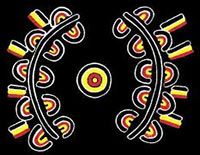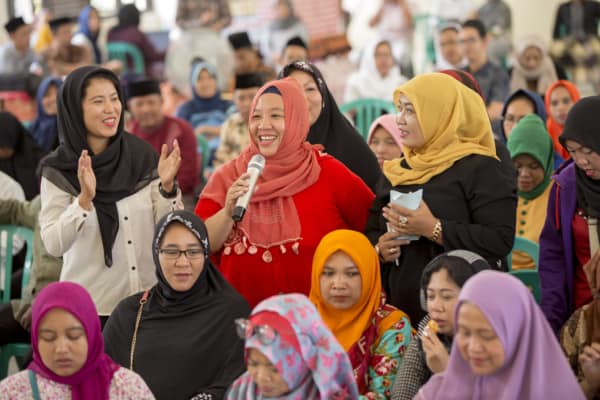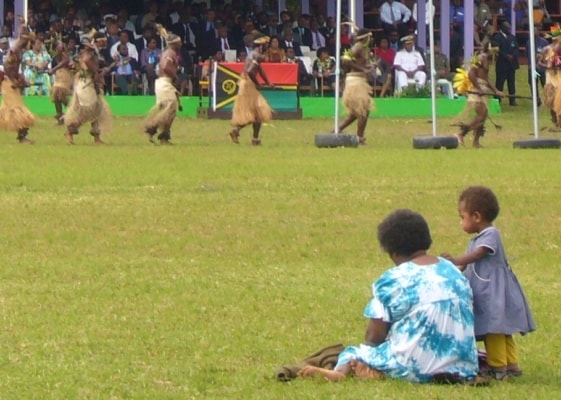Image: Silhouettes, Wirrumanu Aboriginal Community, Balgo Hills, Western Australia (Yaruman5/Flickr).
We came to the DLP conference on ‘power, politics and positive deviance’ to talk about emerging lessons from the Central Land Council’s community development program. The program works to maintain Aboriginal identity, language, culture and connection to country; and to strengthen Aboriginal people’s participation in mainstream Australia by improving their health, education and employment outcomes.
Maximising Aboriginal ownership and control over decisions is a core objective. Funding comes largely from Aboriginal people’s own money – for example, from rents from national parks, and royalties from land-use agreements with mining companies – an approach that some have noted may have broader relevance for the Pacific.
The Central Land Council (CLC) promotes Aboriginal rights. It is a representative body of 90 Aboriginal people elected from the southern half of the Northern Territory, and it has its origins in the history of Aboriginal struggle for justice and the realisation of rights to our traditional land. It was set up under the Aboriginal Land Rights (Northern Territory) Act of 1976, which gave ownership of most of the Aboriginal reserve lands in the Northern Territory to the Aboriginal communities. They were also given the opportunity to claim other land not already owned, leased or being used by someone else. The CLC region covers 771,747 square kilometres of rugged and often inaccessible areas and represents 15 different Aboriginal language groups.
The CLC’s community development program, which began in 2005, has become one of the largest self-funded and demand-driven development programs of its kind in the Northern Territory.
We would argue, of course, that in one sense this program is not ‘deviant’ at all – it ‘goes with the grain’ of indigenous political and cultural realities. However, when our experience is compared to much of the work which seeks to support Aboriginal people in Australia, working in this way – where communities decide their priorities and allocate their own income – remains the exception rather than the rule.
It is an approach, though, that has brought some encouraging results. In 2013, an independent, government-funded evaluation of CLC’s development work found the following.
- Between 2005 and 2013, AUD 25.2 million of Aboriginal funds was used for community benefit (in addition to AUD 8 million of leveraged funds). Expenditures grew from about AUD 500,000 a year in the first two years to AUD 5 million a year in the last four. This shows that commitment to the collective spending of community income has gathered increasing support among Aboriginal people.
- The outcomes of the projects are clearly valued by Aboriginal people and have produced longer-term collective benefits than individual royalty payments. They include: employment opportunities; enhanced training and education outcomes; skills development; improved early childhood development and education; youth engagement; cultural strengthening and maintenance; and enhanced health and overall well-being for kidney patients.
- Within a context of broader disempowerment, Traditional Owners and community residents across central Australia have been empowered by this program because it creates forums and processes through which a critical mass of Aboriginal people across central Australia are able to analyse, identify and address their self-determined needs and priorities. People have contrasted their resulting sense of empowerment with their lack of voice and power in relation to their local shire and schools, and government more generally.
What factors have made the program successful?
The review stressed the importance of its context-specific approach. The CDU’s simple and consistent process of community engagement supports a comprehensive understanding of existing skills, capabilities and institutions, and a ‘good fit’ with the local context.
The focus on local power, agency and voice has made sure that the Aboriginal communities – including the less powerful groups within them – are genuinely involved in decision-making. Program staff have helped maximise limited resources by fostering networks of collaboration, and Aboriginal voice within those networks. This brokering of relationships has helped overcome difficulties such as outsiders’ poor understanding of local governance mechanisms and service providers’ weak accountability and coordination.
The CDU’s work has been most successful where community development staff have shown a desire to work in a culturally respectful way, incorporating Aboriginal ways of doing business alongside organisational policies, guidelines and institutional norms.
Finally, regular independent monitoring and evaluation based on quality data has underpinned critical reflection and learning. It supports adaptation to complex and uncertain circumstances and stronger social accountability and community feedback mechanisms.
Of course, the positive tenor of the evaluation needs to be balanced by the reality of the challenges that Aboriginal and Torres Strait Islander people still face in Australia. But we believe the ‘with the grain’ deviance of this program is a reliable signpost towards a different way of doing things.












